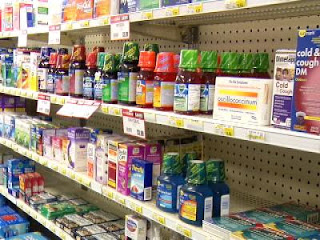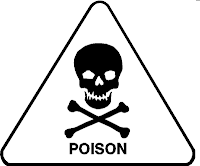What to do?
You have three options.
1. Don't do anything. Let it run its course.
This is an okay option, but really, who wants to just be sick? In our fast-paced, highly demanding culture, most of us don't have time to be sick. We want to get better, and we want it now! Also, this option can lead to bigger and "badder" things down the road - laryngitis, bronchitis, pneumonia...those are not good things to have, and they just require even more of our time.

2. Take some over-the counter cold medication.
This is the overwhelmingly common route. Unfortunately, it's the worst out of the three.
My Asian Medicine professor back at CCNM always said, "Over the counter cold and flu medications lower your fever, dry up your nose, and stop your cough. You just took away three of your body's natural defenses against cold and flu bugs."
And it's 100% true.
Let's take a look at a common cold and flu product:
Nighttime formula INGREDIENTS
Active Ingredients (in each 15 ml tablespoon) (Purpose)
Acetaminophen 325 mg (Pain reliever/fever reducer)
Dextromethorphan HBr 15 mg (Cough suppressant)
Doxylamine succinate 6.25 mg (Antihistamine)
DAYtime formula INGREDIENTS
Active Ingredients (in each 15 ml tablespoon) (Purpose)
Acetaminophen 325 mg (Pain reliever/fever reducer)
Dextromethorphan HBr 10 mg (Cough suppressant)
Phenylephrine HCl 5 mg (Nasal decongestant)
Acetaminophen: analgesic (pain reliever) and antipyretic (fever reducer). When we're sick, our bodies crank up the heat to kill the viruses and/or bacteria that are invading them. Why do we want to turn this off?
Dextromethorphan: antitussive (cough suppressant). We generally don't cough for no reason. There's usually something irritating the lungs or the throat when we cough. When we have a cold, that's usually mucous. It's gross, but cough it up, you get better, cough goes away. Don't cough it up, and it putrefies and often creates the perfect breeding ground for a secondary infection like bronchitis or pneumonia.
 Doxylamine succinate: sedating antihistamine and belongs to a class of medications known as anticholinergics. What these substances do is decrease mucous production in the nose and throat (which can actually make sore throats feel worse), dry the mouth, decrease sweating, urination, and bowel movements. For a body that's trying to get rid of infected cells and the waste products of the immune system's attack on the virus/bacteria, this is pretty detrimental. Furthermore, mucous in smaller amounts is a protective barrier for the body's "mucous membranes", hence the name. Reduced urination can also increase the risk of urinary tract infections, especially in women - that's the last thing you want if you already have a cold!
Doxylamine succinate: sedating antihistamine and belongs to a class of medications known as anticholinergics. What these substances do is decrease mucous production in the nose and throat (which can actually make sore throats feel worse), dry the mouth, decrease sweating, urination, and bowel movements. For a body that's trying to get rid of infected cells and the waste products of the immune system's attack on the virus/bacteria, this is pretty detrimental. Furthermore, mucous in smaller amounts is a protective barrier for the body's "mucous membranes", hence the name. Reduced urination can also increase the risk of urinary tract infections, especially in women - that's the last thing you want if you already have a cold!
Phenylephrine HCl: alpha1-adrenergic receptor agonist (used primarily as a decongestant). This medication works by decreasing the blood flow to the blood vessels of the nose and sinuses, which leads to decreased mucosal swelling in the nose. Again, you just need to think about why this symptom is happening in the first place to determine whether this medication is detrimental or not. Plus, these decongestants are a prime example of everyone's favourite physics law: For every action there's a reaction. Upon stopping this drug, many people experience rebound swelling of the nasal and sinus mucosa that can sometimes be worse than it was to begin with!
This post was only supposed to be about the pharmaceutical ingredients and their detrimental effects on healing from colds and flus, however, I can't not mention the "other stuff" that you're getting with these medications.
Night Formula Inactive Ingredients
Soothing Cherry: acesulfame potassium, alcohol, citric acid, FD&C Blue No. 1, FD&C Red No. 40, flavor, high fructose corn syrup, polyethylene glycol, propylene glycol, purified water, saccharin sodium, sodium citrate
Day Formula Inactive Ingredients
Carboxymethylcellulose sodium, citric acid, disodium EDTA, FD&C Yellow No. 6, flavor, glycerin, propylene glycol, purified water, saccharin sodium, sodium benzoate, sodium chloride, sodium citrate, sorbitol, sucralose
Acesulfame potassium, saccharin sodium, sucralose: artificial sweeteners = poison
High fructose corn syrup: one of the worst forms of sugar you can consume and linked to virtually every chronic disease that is prevalent in Western society
FD&C Blue No. 1, FD&C Red No. 40, FD&C Yellow No. 6: toxic and linked to behavioural problems and hyperactivity in children. Many are also banned in various countries
Polyethylene glycol: petroleum-based compound often contaminated with ethylene oxide and 1,4-dioxane (The International Agency for Research on Cancer classifies ethylene oxide as a known human carcinogen and 1,4-dioxane as a possible human carcinogen).
Propylene glycol: found in automatic brake and hydraulic fluid, industrial antifreeze, cosmetic products, stain removers, fabric softener, degreaser, adhesives, wallpaper stripper...you get the point, not something you really want to consume (even if it's in smaller concentrations). The form used in cosmetics is known to be a skin irritant and can cause liver abnormalities and kidney damage.
Sodium benzoate: a preservative, known to be neurotoxic to aquatic animals and is toxic/lethal to humans in high doses, endocrine disruption and toxic to the liver at higher doses. Most worrisome is when it combines with vitamin C (ascorbic acid) or citric acid (look above and you'll see citric acid in both the day and night formulations). This combination creates benzene, a known carcinogen!
So, as you can see, even the "inactive" ingredients are trouble! Definitely not something you want to ingest at any time, but especially not when you're fighting off a cold.
Finally, I'll get to your last option when you have a cold:
3. Take something natural!
If you're reading this article, I'm sure you've probably already come to this conclusion, too. By taking something natural, you are treating the cause: the infection. You're also working with the body, instead of against it. You will most likely be sick for a shorter duration (or avoid getting sick altogether if you catch it early enough!) and drastically reduce your chances of developing any secondary infections like bronchitis or pneumonia.
You may be thinking, that's all fine and dandy, but what do I take? You want to look for herbs with the following actions (adapted from Medical Herbalism by Hoffman):
Antimicrobial: help the body to destroy or resist pathogens, either by directly interacting with a pathogen or via the herb's interaction with the immune response. These are useful in virtually all types of infections. Herbs such as garlic, echinacea, and goldenseal fall into this category.
Anticatarrhal: these work by making mucous less viscous so that it's easier for the body to remove and are useful in ear, nose, and throat infections. Herbs such as yarrow and goldenrod fall into this category.
Demulcent: rich in mucilage and can soothe and protect irritated or inflamed internal tissue. These can be very soothing to sore throats due to infection or coughing, without adversely affecting the immune response. Herbs such as marshmallow, slippery elm, and cornsilk fall into this category.
Expectorant: herbs that facilitate or accelerate the removal of bronchial secretions from the bronchi and trachea. These don't stop the cough, they work with the body to make it work more efficiently! There are expectorant herbs suited to dry, irritating coughs as well as those better suited to wet, productive coughs. Herbs such as elecampane, sundew, horehound, and coltsfoot fall into this category.
As you can see, these actions are a lot more in line with nature and the body's natural immune response than the pharmaceuticals listed above. If you feel a cold coming on or already have one, see your ND to send those bugs packing so you can get back to normal, quicker!
The information in this blog is designed for educational purposes only. It is not intended to be a substitute for informed medical advice or care. You should not use this information to diagnose or treat any health problems or illnesses without consulting your doctor. Please consult a doctor with any questions or concerns you might have.





